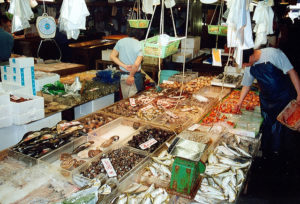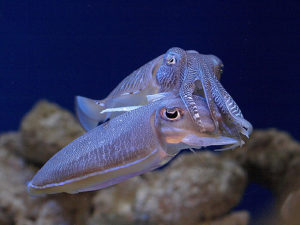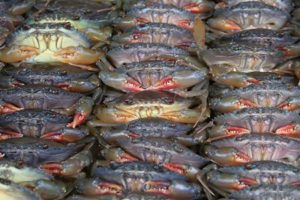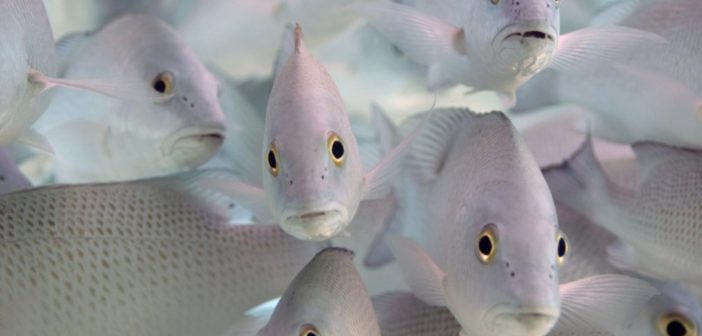Since 2015, the Swiss anti-speciesist association PEA (Pour l’Egalité Animale [For Animal Equality]) is drawing the attention of animal activists and the general public to aquatic animal sentience and to the ways aquatic animals suffer at the hands of humans. To this end, we have launched a global campaign called “Another Perspective on Fish” to raise awareness of these forgotten animals. PEA provides activists with leaflets and banners, and is putting on a large exhibition.
Part of this campaign will be the World Day for the End of Fishing (WoDEF), on March 30th, which will call for an end to fishing and fish farming for ethical reasons. Sentient animals, aquatic or not, have their own interests that must be taken into account. More than 70 cities in 17 different countries participated in WoDEF events in 2018.
Below you will find part one, presenting text from four of the twelve panels of the exhibition. This portion of the exhibition introduces some aquatic animals and briefly explores their sentience. Further portions of the exhibition will be published on Animal People Forum in the future, explaining what fisheries and fish farming mean for these animals and why we must call for their abolition.
Who are fish and other aquatic animals?

Tsukiji Fish Market in Tokyo, Japan. Image credit Arian Zwegers, CC BY-SA 3.0.
There are tens of thousands species of fish, not to mention the many other aquatic animals. Their habitat covers three quarters of the planet, yet most of us know very little about them. Because of this, humans decimate them on a large scale and put them in terrible conditions.
Consideration for animals in general is increasing, unfortunately this is largely untrue for fish, even though they represent a huge majority (95%) of the animals killed for food. Between 1,000 and 3,000 billion fish are killed globally every year, and very little is done to stop this inconceivable massacre.
Fish do feel pain. They have a distinctive personality traits and they recognize individuals of their species, with whom they communicate. Octopuses and squids also have remarkable cognitive capabilities. They feel pain too, as do lobsters, crabs and shrimps.
Just because many of us feel less automatic sympathy for aquatic animals, that doesn’t mean that their lives and their happiness have less importance. It is their lives and their happiness which matters first of all, before human sympathy and preferences.
Beings with amazing skills
Our planet contains an outstanding diversity of fish species. They are much more fascinating than we originally suspected. Fish behavior research repeatedly shows that fish have complex minds. They have complicated social lives, they build alliances (sometimes with individuals from other species), demonstrate the use of strategy, calculate the costs and benefits of their actions, communicate in elaborate ways, learn and remember for long periods of time, are curious and perceptive, and much more.

Sockeye running up the Kenai River to spawn. Photo credit: Kentaro Yasui, CC BY-SA 3.0.
Contrary to a persistent myth, fish do have long-term memory. For example, salmon find their way back to their native river, using their sense of smell, after having spent years thousands of miles away.
Gobies also show some surprising spatial abilities. These fish live in small ponds that form among rocks at low tide. When a bird tries to eat them, the gobies jump from one pond to another, without smashing into the rocks, even though they can’t see the other pond. They do this by memorizing nearby landforms during high tide, visualizing the recesses, and then deducing the location of the ponds at low tide. An experiment conducted in an artificial pond has shown that they only need one high tide to memorize the topography of the ponds.
Above all, and contrary to popular belief, it has been scientifically proven that fish feel pain and fear. This capacity for suffering is the primary reason why we must take their interests into consideration.
Aliens of the sea

Two cuttlefish interacting at the Monterey Bay Aquarium. Image credit Charlene-SJ, CC BY-SA 3.0.
Cephalopods (octopuses, cuttlefish, and squids) are amazing invertebrates: they have blue blood, three hearts, and eight to ten arms that can feel and taste by themselves. Their nervous systems are widely distributed through their whole body and they have large brains. Their tentacles can react independently, even when severed, and can also regenerate. Some species can change their color or shape and emit flashes of light. The Caribbean reef squid can communicate with other squids by changing color, and can send differing messages to different squid by changing to one color on the left side of their body and another on their right. To deter predators, some octopuses mimic the color, shape and pattern of movement of predatory fishes.
The cognitive capacities of octopuses continue to astonish researchers and aquarium employees. An octopus named Otto was known to climb up the side of his tank to squirt water at an annoying spotlight, inducing short-circuits to turn it off. Recently, another octopus named Inky freed herself from her tank and is thought to have gone through a drain pipe and off into the sea. Sid, an octopus that was kept at the New Zealand Marine Studies Center, also eventually gained freedom after many escape attempts.
Cephalopods are intensively fished with seine nets, trawlers and longlines – all fishing methods which inflict intense suffering. In 2016, approximately five million metric tons of cephalopods were caught by fishermen, an amount equivalent to 135,000 trucks of 35 metric tons each. This means death to billions and billions of animals.
Sentience under the shell
Crabs, shrimp, lobsters and crayfish are targeted by massive fishing operations, and intensive shrimp farming is growing exponentially. In 2016, fishing and farming each killed seven million metric tons of crustaceans, amounting to several hundred billion deaths.
Fishing for crustaceans devastates the sea floor. Two thirds of catches are comprised of other marine animals besides those that are intended to be caught, so-called “bycatch.” Farmed crustaceans are fed fish who were caught in the wild, causing even more death and suffering.

Stacked live crabs at a wet market in Vietnam. Image credit Sputnik Satellite, CC BY-SA 3.0.
The nervous systems of crustaceans are less centralized than those of fish, but complex enough for them to feel pain. When they are killed for food, lobsters and crabs are usually dismembered and/or boiled alive. They live through this hell for up to several minutes, until their peripheral nervous system is destroyed. In some industrial practices, lobsters and crabs are submerged in fresh water, which slowly and painfully kills them, taking up to two hours of agony.
Wild lobsters can live more than a hundred years, if left alone. Once captured, they are packed one on top of another with their claws tied, and can be left in boxes for more than a month.
This suffering and these deaths are inflicted in the name of human desires. This is morally unacceptable. Crustaceans should have the right to live, free from torture.
This portion of the Another Perspective on Fish campaign can be seen in its original form here.
Featured image: A school of dog snappers. Image credit actor212, CC BY-SA 3.0.





